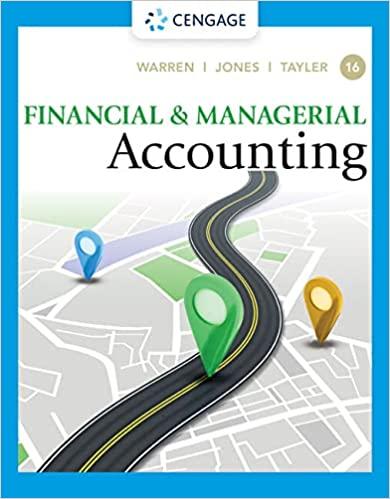Question
Please answer the following requirement based on the scenario: Assume you are a staff auditor employed by Hart, Reed, and Yates LLP (hereafter HR&Y), a
Please answer the following requirement based on the scenario:
Assume you are a staff auditor employed by Hart, Reed, and Yates LLP (hereafter HR&Y), a large, regional public accounting firm. Because local governments typically have a June 30 fiscal year end, HR&Y accepts government audits during the traditionally slower audit season of summer. As a result, HR&Y audits several large municipalities in the state. The municipal audit fees represent approximately 35% of the firm's auditing revenues. You have recently been assigned to work on the compliance portion of the single audit of Sagebrush City, a mid-sized municipality in Texas. You have never worked on the audit of a state or local government and are unfamiliar with the requirements of the Single Audit Act or with federal regulations regarding tests of compliance.
An engagement under the Single Audit Act involves testing and reporting on compliance with federal laws for entities that receive federal financial assistance, along with an audit of the basic (general purpose) financial statements. Recipients of federal funds include states, counties, non-profits, and municipalities. The federal government requires single audits to ensure that federal monies are properly spent by grant recipients. For example, a government that administers a Federal Food Stamps grant must have policies and procedures in place to make certain that only persons who are eligible for food stamps actually receive the benefit. To determine whether a person is eligible, an auditor might test the application file of someone currently receiving food stamps to ensure that established criteria are being met.
During a planning meeting for the Sagebrush City audit, the audit manager on the engagement, Sarah Miller, informed you that few auditors at HR&Y had knowledge of governmental auditing before they were put on municipal engagements. According to Sarah, most collegiate accounting programs she knew of only briefly discussed audit requirements for federal programs, despite the fact that government audits account for a substantial proportion of the audit revenue generated by many accounting firms. She told you that while public accountants performed about 6,000 audits of publicly-held corporations each year, they perform over 35,000 single audits under the OMB Uniform Grant Guidance and the Compliance Supplement. Sarah also gave you the following background information to help you obtain an understanding of a municipal audit.
The Single Audit Act (SAA), passed in 1984, provides guidance to auditors of state and local governments on how to audit entities that receive federal funding. The SAA is described in the OMB Uniform Grant Guidance, which details when an audit of federal programs is required as well as the auditor's responsibilities. The OMB Uniform Grant Guidance is available online at www.grants.gov/learn-grants/grant-policies/omb-uniform-guidance-2014.html.
Prior to the SAA, federal agencies responsible for disbursements of federal funds generally required audits for each contract, grant, or program. Governmental entities with multiple grants, contracts, and programs were subjected to numerous different audits conducted by a variety of auditors, each with a specific, limited scope. To establish uniform requirements for audits of federal financial assistance, as well as to improve the financial management and accountability of state and local governments (SLGs), the SAA was enacted.
Requirement:
Michael Hart, one of the founders of your firm, is on the board of directors of the local chapter of the state society of CPAs. He has asked Sarah Miller to provide a continuing education speech for the chapter and encouraged her to solicit help from her staff. Sarah will be speaking about auditors' reporting responsibilities for single audits of state and local governments, and she has asked you to handout for participants in the class. She has reminded you that this should be a "take away" and easy for the audience to read.
In the handout, you must include information on the required audit reports for government audits. Your handout must also include definitions of (a) significant deficiencies; (b) material weaknesses; (c) illegal acts; (d) non-compliance; (e) fraud; (f) abuse; (g) waste; and (h) questioned costs. For each of these items, you may quote the authoritative literature, but you must provide appropriate citations. In addition, explain the auditors' responsibilities for these items (a-h) under government auditing standards and whether these responsibilities differ from generally accepted auditing standards published by the AICPA. Sarah has asked you to specifically address the difference between non-compliance and illegal acts in the outline.
Sarah suggests that Uniform Grant Guidance Section 200.515, chapters six and seven of the Yellow Book (available online at https://www.gao.gov/assets/gao-21-368g.pdf), and auditing standards established by the AICPA (available online at https://www.aicpa.org/research/standards/auditattest/clarifiedsas.html) might be helpful in preparing the outline.
Step by Step Solution
There are 3 Steps involved in it
Step: 1

Get Instant Access to Expert-Tailored Solutions
See step-by-step solutions with expert insights and AI powered tools for academic success
Step: 2

Step: 3

Ace Your Homework with AI
Get the answers you need in no time with our AI-driven, step-by-step assistance
Get Started


